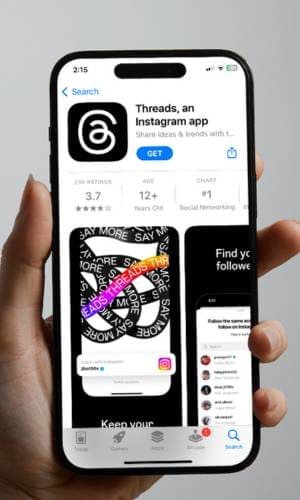 When Threads launched on July 4, 2023, it took the world by storm. Particularly as Twitter, now known as “X,” has floundered, Threads seems not only like a viable alternative but an outright replacement. Several of my followers have proactively asked me about making the switch or integrating Threads into their media strategies. I advise them not to move just yet. Give me a few moments, and I’ll walk you through the reasons.
When Threads launched on July 4, 2023, it took the world by storm. Particularly as Twitter, now known as “X,” has floundered, Threads seems not only like a viable alternative but an outright replacement. Several of my followers have proactively asked me about making the switch or integrating Threads into their media strategies. I advise them not to move just yet. Give me a few moments, and I’ll walk you through the reasons.
Why You Shouldn’t Move to Threads Yet
Launched by Meta, the creator of Facebook and Instagram, Threads has been described as either “Instagram without the photos” or a “Twitter alternative.” Given its background and the flood of people who jumped on the platform during its launch, Threads has excellent potential. However, it’s too soon for small and midsized businesses to make the jump.
Your Resources Are Limited
Your business has a limited budget and time. You’ll need to reallocate resources from another digital marketing initiative to leverage Threads. That may eventually be a solid strategic move, but as we’ll cover, there isn’t enough data to support the decision yet. In other words, moving to Threads now likely means you’re removing resources from something that is working for you and applying them to something that may not produce results.
Your Audience May Not Be on Threads
As it stands now, it’s impossible to know which audiences will leverage Threads. We can make an educated guess that it will be similar to X’s audience, but we don’t necessarily know this. Consider the evolution of TikTok, for example. It more or less started as a dance app leveraged almost exclusively by teens. Now, a broad audience uses the platform, and only a portion of the content relates to dance. Social media app developers often have expectations about how their platform will be used that don’t match real-life usage. Until Threads stabilizes, we can’t know who will use it or how.
This also means that if you’re reallocating resources to leverage threads, you are leaving behind an audience you’ve already worked hard to attract. You have followers who engage with you that you may lose as your posts dry up on other channels.
The Concept is Unproven
We had every reason to think that Threads would be huge based on initial adoption. It boasted 2.3 million users in the U.S. alone during its first week, per SimilarWeb data. Within a month, about three-quarters of users dropped off.
Threads is not the first social network to take a nosedive. It’s not even the first from Facebook that’s struggled. FriendFeed, for example, was launched in 2007 by a group of former Google employees, as Search Engine Journal reports. Facebook picked it up in 2009. It then limped along until 2015, when the company shut it down. Then, there was the video app Vine, which Twitter picked up before its launch in 2013. It vanished in 2016. Even Google has failed several social media attempts, including Google Wave, Google Buzz, and Google Plus.
While Threads may eventually recover and grow into a social media platform worthy of your time, it’s too soon to tell. Any investment you make in the network will be lost if it doesn’t survive. Given that the resources you apply to Threads will likely be pulled from other proven initiatives, you’re not just out the resources. You will have missed out on the growth the other channel would have provided. If your competitors stayed the course, you’ve also given them an edge.
Manual Posting is Required
I always advise my clients to leverage a scheduling tool as part of their overall social media strategy. Examples include platforms like Buffer, Sprout Social, and Hootsuite. These tools can save hours each week over posting manually and make it easy to measure performance.
However, scheduling tools rely on an API or application programming interface. An API is an intermediary that exchanges data between the scheduling tool and social network. Most social media networks create their own APIs. That ensures they work correctly and minimizes security issues. Threads has not released an API yet. While there are third-party APIs for the platform, they’re not necessarily from reliable or trustworthy sources, and there’s no guarantee they’ll continue working.
Because of this, no social media scheduling tools include the ability to post to Threads yet. That means all your posts must be performed manually, directly on the platform.
Security is Questionable
You can only log into Threads via the Apple or Android app at this stage. You cannot manage posts or your account via desktop. That means, unless you’ve issued phones or tablets to your staff, they can only manage your Threads account through their personal devices. While some password management tools work on mobile devices, marketing teams do not leverage them nearly enough. That means most companies leveraging Threads are exposing themselves to unnecessary risk, including potential theft, network hijacking, and employee or former employee abuse.
What to Do if You Want to Use Threads Now Anyway
Despite hearing all these risks and concerns, you may still be excited about Threads and have concerns about missing out on the opportunity to become an early adopter. While I will still urge you to wait until all the above issues are addressed, there are a few low-risk activities you can engage in that can help tide you over.
Claim Your Username
It’s always a good idea to claim your brand name on social media networks as part of your trademarking initiatives. That way, nobody else can use them, even if you’re not leveraging the platform. Think of it as a form of insurance that protects your branding.
You presently need an Instagram account to create a Threads account, and your Instagram name becomes your Threads account name. There’s no way to circumvent this or change your Threads name. Because of this, it’s a good idea to ensure you have an Instagram account for your brand and claim your Threads account through it.
Monitor the Channel
Periodically check Threads to see how it’s performing for your industry. See if you can find industry news being shared or engagement between members on topics related to your brand, services, or products. Keep an eye out for competitors as well. Their presence on the platform doesn’t signal you’ll have success there, but if you see strong engagement with specific post types, you may be able to use the information to shorten your learning curve if you use Threads later.
Test Periodically
If you have the resources to test Threads without drawing resources away from a proven network and see promising results when monitoring the platform, you can run test posts periodically for a couple of months and measure the response. For instance, if you’re already using Twitter, try cross-posting one post per week on Threads. That way, you can compare the engagement rates with minimal resource investment.
Get Help Strengthening Your Social Media Strategy
Leveraging new tools and technology can improve your digital marketing results, but it’s essential to ensure each new thing you integrate brings real value to your strategy. If your brand needs help to shore up its social media strategy or wants to level up its digital marketing in general, I can help. Please contact me for a complimentary consultation.






































































